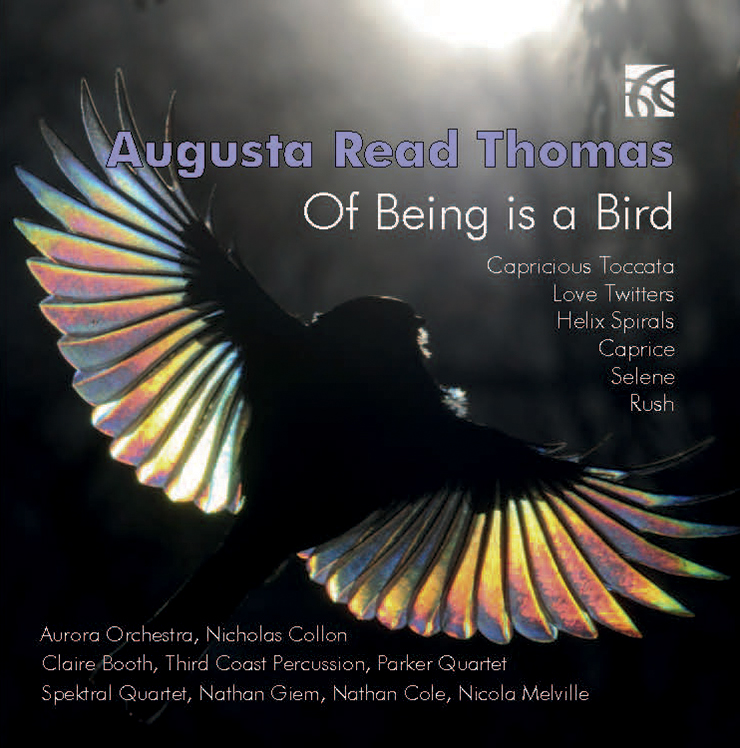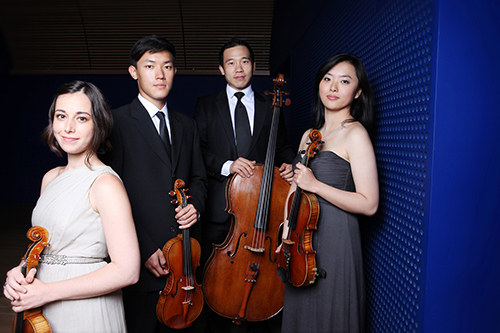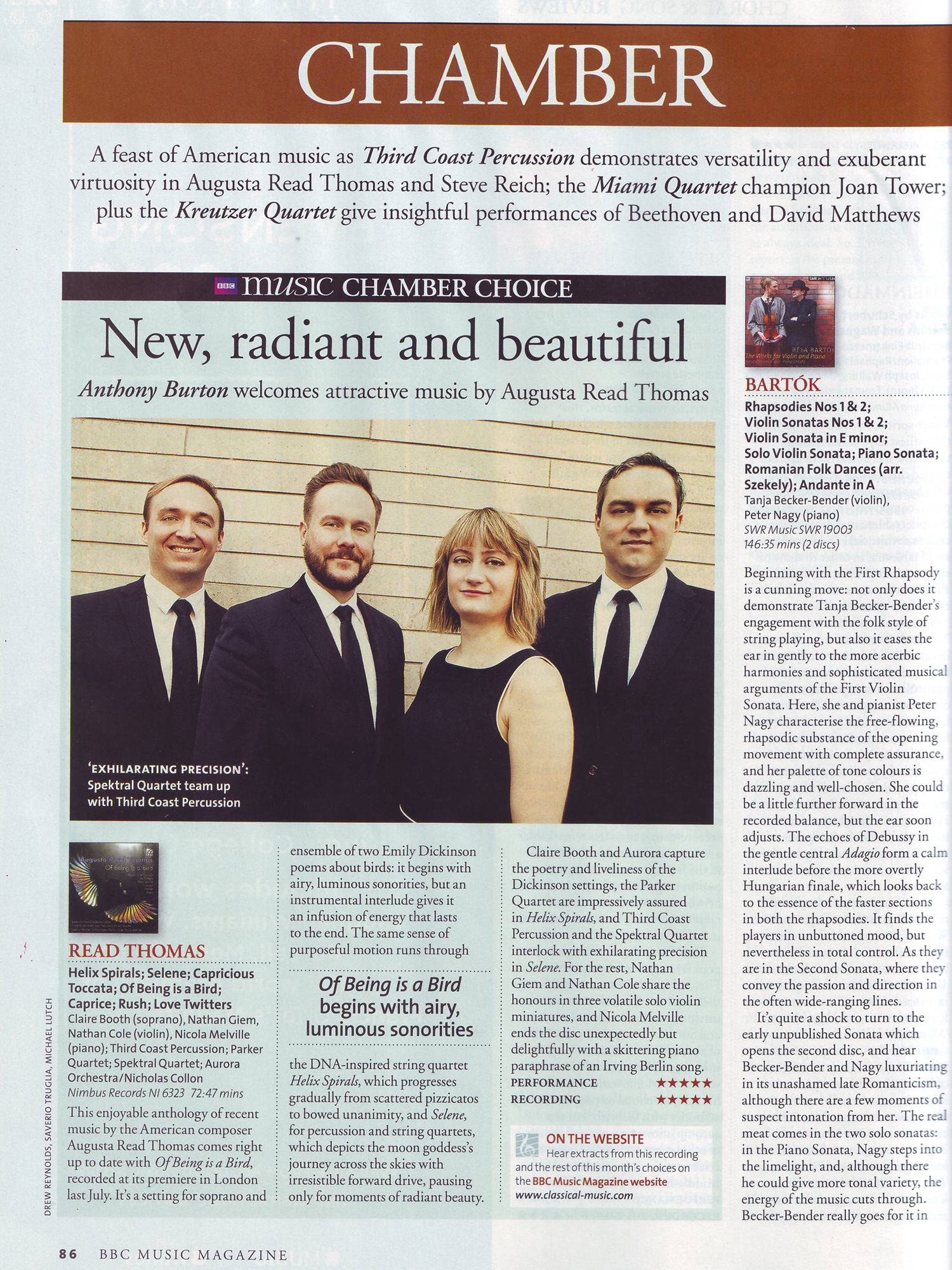Commissioned by Jeanne Guillemin in celebration of the Meselson-Stahl DNA replication discovery, 1958
Premiered by the Parker Quartet at Harvard University, 10 April 2015
Duration: 23 minutes

A sample extracted from the middle of Movement #1 as played by the Parker Quartet
A sample extracted from the end of Movement #2 as played by the Parker Quartet
From Movement #3 — final 2:45 of the composition
Curtis 2021 Ensemble - Augusta Read Thomas: Loci: Memory Palace from Helix Spirals, Claire Bourg, violin; Takumi Taguchi, violin; Grace Takeda, viola; John Lee, cello

This work is available on
Augusta Read Thomas - Of Being Is A Bird

HELIX SPIRALS for string quartet
"in celebration of the Meselson-Stahl DNA replication discovery, 1958"
HELIX SPIRALS is in three movements, which are to be played with a short pause between each movement.
I: LOCI: memory palace — approximate duration 7 minutes and 30 seconds
II: INTERLACING: twists and threads — approximate duration 6 minutes and 30 seconds
III: SPIRALS: life force — approximate duration 8 minutes and 30 seconds
Movements can be played together, in the order listed above, or any movement can be played independently as a stand-alone work, or any two movements can be played as a pair in any order.
I have always adored the second movement of Maurice Ravel’s String Quartet in F major. (The “Pizzicato” movement.) HELIX SPIRAL I: LOCI: memory palace is my “response” (for lack of a better word) to my love of the Ravel. Playing the two short movements (Ravel, Thomas) side by side, could make a really delightful pairing.
Duration: 22 minutes and 30 seconds
First Performance: April 10, 2015: premiered by the Parker Quartet at Harvard University.
When played complete, the work should be listed on programs as
HELIX SPIRALS for string quartet ![]() Augusta Read Thomas (1964)
Augusta Read Thomas (1964)
I: LOCI: memory palace
II: INTERLACING: twists and threads
III: SPIRALS: life force
When played in individual movements, they should be listed on programs as:
HELIX SPIRAL I: LOCI: memory palace for string quartet
HELIX SPIRAL II: INTERLACING: twists and threads for string quartet
HELIX SPIRAL III: SPIRALS: life force for string quartet
Two online talks about the Meselson-Stahl DNA replication discovery experiment are here:
![]() Matthew Meselson: The Semi-Conservative Replication of DNA
Matthew Meselson: The Semi-Conservative Replication of DNA
![]() The Most Beautiful Experiment in Biology: Meselson & Stahl
The Most Beautiful Experiment in Biology: Meselson & Stahl
“Helix Spirals combines explosive energy, technical virtuosity, and vivid colors and textures with an intellectual rigor of conception that lends it formal continuity and cohesion. This exciting work deserves a place in the repertoire.”— Matthew Heck, The Boston Musical Intelligencer
Helix Spirals for string quartet celebrates the Meselson-Stahl DNA replication experiment. Here is how Yale historian Frederic Lawrence Holmes described this singular achievement of Matthew Meselson and Franklin Stahl:
In 1957 two young scientists at the California Institute of Technology performed an experiment that provided convincing evidence that DNA replicates in the manner predicted by the model of the double helix proposed four years earlier by James Watson and Francis Crick. Its timely appearance, after several years of controversy about whether the two strands of DNA could come apart without breaking, not only settled the issue as it was originally posed but persuaded many, beyond the immediate circle of enthusiastic supporters, that the double helix was more than an "ingenious speculation." Quickly known by the surnames of the two men who performed it, the Meselson-Stahl experiment became a classic model in the young field of molecular biology. It has been reproduced in schematic form in textbooks of molecular biology, biochemistry, and genetics for more than three decades. It is seen not only as a landmark but as possessing special qualities that lift it above the thousands of other experiments on which the modern biological sciences have been constructed.
Jeanne Guillemin and I spoke at length about the project and we agreed from the start that music is music and science is science. That being so, for a composer to use exact data (for instance, the code in a DNA sequence) and then assign pitch or rhythm to each data point, might result in something interesting but would, most likely, never be a strong musical composition which effectively, dramatically, expressively, and musically sculpts time over a 24-minute arc. If, though, one moves into the realm of metaphor, great synergies exist between science and music; and it was in this realm that Jeanne and I started our collaboration — celebrating that music can be an abstract and intellectual expression of nature.
The four string parts are equally and evenly virtuosic. There are many solo moments for each member of the quartet allowing the musicians' individual skill, elegance and radiance to shine.
The three movements encompass a vast array of contrasting colors, motives, textures, rhythmic syntaxes, harmonies and counterpoints, such that each movement contributes to a larger, 24-minute gestalt.
Deeply honored to have been asked to compose HELIX SPIRALS, I spent eight months working on the music, which is dedicated with admiration to Matthew Meselson, Franklin Stahl, Jeanne Guillemin, and the Parker Quartet.
I: LOCI: memory palace — 7 minutes and 30 seconds - In genetics, a locus (plural loci) is the specific location of a gene, a DNA sequence, or a position on a chromosome. In this movement, the string quartet plays many kinds of colorful sounds in a kaleidoscopic range of combinations and is, (metaphorically speaking) portraying loci with capricious, playful, energized, vibrant, resonant, and lively musical unfoldings.
II: INTERLACING: twists and threads — 7 minutes and 30 seconds - In semiconservative replication, when the double stranded DNA helix is replicated each of the two new double-stranded DNA helices consists of one strand from the original helix and one newly synthesized strand. In this movement, the quartet "draws a picture" of DNA semi-conservative replication. Much of this movement is, by necessity, focused on pairs of instruments but the intricate contrapuntal lines are always enhanced with fleeting, supportive, plucked and bowed materials played by the other two musicians.
The movement starts with violin 1 playing "DNA STRAND A." Forty-five seconds later, the cello takes over playing "DNA STRAND B." [From here to the end of the movement, before every next helix episode, a gentle moment of calm serves as an aural guidepost so that the audience can clearly follow the form.]
After a quiet note in the viola, Violin 2 reiterates "DNA STRAND A" while at the same time the viola restates "DNA STRAND B" such that the whole DNA helix has been revealed.
After another quiet note in the viola, the cello plays the "leading DNA STRAND A" (which was previously played by Violin I) and the Violin 2 plays a new "COMPLIMENTARY LAGGING DNA STRAND."
Next, the Violin I plays the "DNA STRAND B" (which was previously played by the cello and the viola plays a new "COMPLIMENTARY LAGGING DNA STRAND."
By this point in the composition, we have arrived at two double helixes.
After a long quiet note played by the whole quartet, we enter the final episode in which Violin I and Viola link up to play "DNA STRAND A" while Violin 2 and Cello team up to play "DNA STRAND B." In this final episode, we still have the original two DNA strands but they are amplified harmonically and emotionally by nature of the fact that all four musicians are playing.
III: SPIRALS: life force — 8 minutes and 30 seconds - During a phone call with Matthew Meselson, just as I was starting to compose HELIX SPIRALS, he explained, with passion in his voice, that the DNA molecule "holds past memories and present times and that it is a key to the future." "Links and chains" he went on to say. The helix spirals give life, and the DNA molecule encodes the genetic instructions in the development and functioning of all living organisms. In this final movement, the quartet conveys the beauty, richness and expressivity of life. The movement is extremely lyrical, intricately contrapuntal, utterly optimistic, and ever-renewing of its materials and transformations.
— Augusta Read Thomas


Matthew Heck, The Boston Musical Intelligencer
Upbeat Life Forces à la Parker
"Not every premiere introduces exciting new music to the world, nor does every premiere receive a committed and musically sensitive performance that situates it in the company of other works complementary in character and spirit. That's exactly what a packed Paine Hall at Harvard received Friday night, however, as the Blodgett Chamber Music Series at Harvard presented the fabulous young Parker Quartet performing works by Erwin Schulhoff and Felix Mendelssohn that surrounded a thrilling world premiere by Augusta Read Thomas.
"Thomas's Helix Spirals for string quartet, commissioned by scientist Jeanne Guillemin, celebrates the pioneering work of Matthew Meselson and Franklin Stahl, researchers responsible for discovering the nature of DNA replication, in 1958. They confirmed that DNA replicates "semi-conservatively," or by splitting into two strands without breaking, convincing scientists beyond a close group of enthusiastic supporters that the double helix was more than fanciful speculation and quickly making the "Meselson-Stahl experiment" a classic model in the field of molecular biology.
"Thomas spoke about the work before the performance while the quartet offered short excerpts of its diverse textures, explaining that the three movements entitled "Loci: memory palace", "Interlacing: twists and threads", and "Spirals: life force," abstractly highlight three perspectives on the processes, which can also be seen as a series reflecting the evolution of life. "Loci" refers to gene locations, DNA sequences, or positions on a chromosome, and this movement fittingly featured "colorful sounds in a kaleidoscopic range of combinations." The movement begins with a sharp single note that spreads in pitch to neighbors of the diatonic scale and diversifies in timbre featuring an array of pointillistic sparks, from snapped pizzicati to scampering col legno. As Helix Spirals begins it's as though we witness the first molecular bonds among bits of carbon in the primordial soup, and as the first movement unfolds these parts become more and more complex, building into short multi-note motives that recombine and in turn build still other motives.
"The strands constructed from the bits and pieces reveal themselves whole in the second movement, and the musical language for these themes is, fittingly, more complex and chromatic. "Interlacing: twists and threads" "draws a picture of DNA semi-conservative replication," with pairs of instruments playing complementary lines that split and join the others. Episodes in this process of replication are divided by moments of suspension, where the quartet plays a held note, creating a "moment of calm that serves as an aural guidepost", leading the audience through this programmatic form. However, color remains a key component of the texture even in this more thematic second movement, and the quartet members who are not engaged with unraveling one of the strands at any given time add swelling bowed notes and other effects to the lines, catching particular genes and chromosomes to spotlight.
"Only in the final movement, "Spirals: life force", does the music telescope out from the molecular level, or from an evolutionary perspective move millions of years into the future, to reflect the beauty and diversity of life that DNA sustains. With "Spirals", the emotional, almost metaphysical or spiritual connotations of this incredible, delicate process bloom in a way that nevertheless reflects back on and connects intimately with the microscopic components that make it possible. Individual pitches emerge from each musician to collect in groups and play with our tonal ears, suggesting, from one fleeting moment to the next, rich chords and sonorities in an ever shifting harmonic landscape. Thomas declared this movement "optimistic and life-affirming", and those qualities saturate the atmosphere. Major chords mingle with their relative minor, amassing rich combinations of semi-dissonant washes, with individual pitches introduced by each quartet member, moment by moment connected by common tones and differentiated by the process of replacing those tones one by one. Evolution is omnipresent, but the overall sense is peaceful and meditative despite the quick, surging crescendos that mark off episodes from one another. In the midst of this beautiful, detailed final movement, we realize that its pan-diatonic character recalls the same type of pitch collection that defined the vastly different, far more disjointed "Loci" at the beginning.
"The Parker Quartet gave a committed, detailed, and virtuosic reading, and announced that they would enter the studio the following day to record this vital new piece for Nimbus Records. Thomas's Helix Spirals combines explosive energy, technical virtuosity, and vivid colors and textures with an intellectual rigor of conception that lends it formal continuity and cohesion. This exciting work deserves a place in the repertoire, and hopefully the Parker Quartet will perform it widely and persuade other ensembles to follow their lead."
![]() Original Link (The Boston Musical Intelligencer)
Original Link (The Boston Musical Intelligencer)
Allan Kozinn is a former music critic and culture writer for The New York Times who lives in Portland, The Portland Press Herald. "Thomas's piece is inspired by the structure of DNA and creates fascinating imagery through its use of full-ensemble pizzicato in the first movement and attractively interwoven, slowly swirling themes through its other two movements."
Bernard Jacobson, Seen and Heard International
"A Composer Portrait Combining Substance, Brilliance, and Sheer Fun
Thomas had marshaled her materials to such compelling purpose that when a momentary silence soon after the beginning reappeared just before the end, it conveyed a very real sense of recapitulation — of imminent closure; and to make a silence carry that kind of structural weight takes a good deal of compositional skill. (The most important part of music, Debussy declared, is not in the notes but in the space between them.) …arresting in invention, and pithy in expressive character..."
To obtain examination or performance material for any of
Augusta Read Thomas's works, please contact G. Schirmer Inc..
